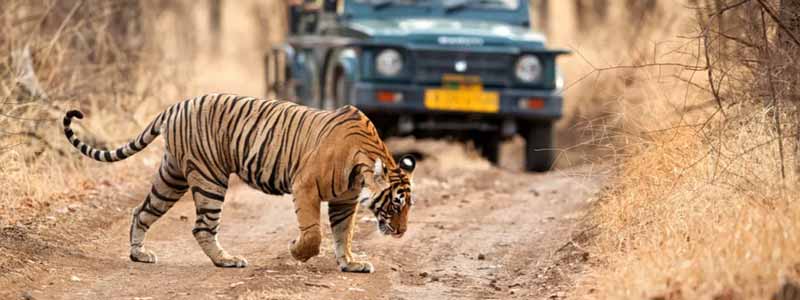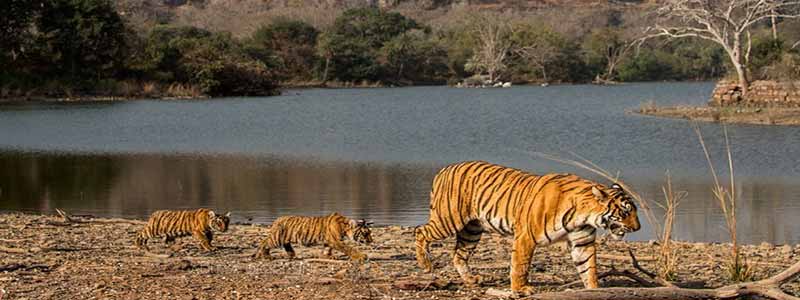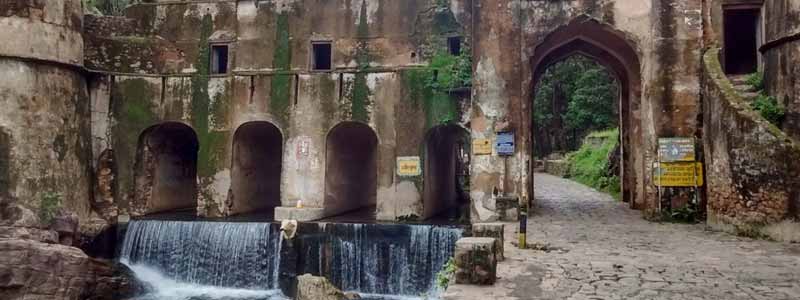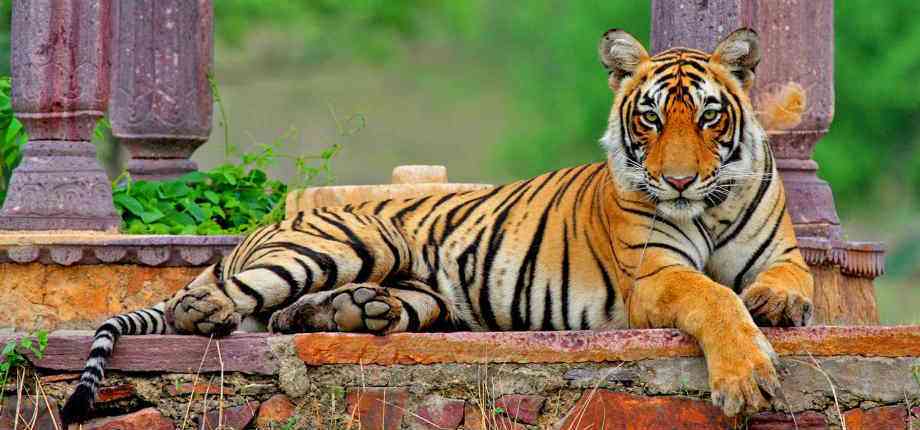Safari Zones in Ranthambore National Park, located in the Sawai Madhopur district of Rajasthan, India, is renowned for its rich biodiversity and, in particular, its population of majestic Bengal tigers. In an effort to promote wildlife conservation and offer visitors a unique experience, the park authorities have established Safari Zones within the park. These designated areas provide controlled access to the park, allowing tourists to explore its natural wonders while minimizing disturbance to the wildlife.
The Safari Zones in Ranthambore National Park are carefully demarcated regions that offer different landscapes and habitats, providing visitors with diverse opportunities to spot wildlife. Each zone has its own distinct features, such as lakes, hills, and dense forests, which contribute to the overall diversity of the park.
One of the primary objectives of the Safari Zones is to enhance the chances of tiger sightings. Ranthambore is home to a significant tiger population, and the park is renowned for its successful tiger conservation efforts. The Safari Zones are strategically planned to increase the chances of visitors encountering these magnificent creatures in their natural habitat. Safaris are conducted by trained guides and drivers who possess extensive knowledge about the park and its wildlife, ensuring a safe and informative experience.
Apart from tigers, the Safari Zones provide opportunities to observe a wide range of other wildlife species. Ranthambore is teeming with diverse flora and fauna, including leopards, sloth bears, sambar deer, crocodiles, and numerous bird species. The park’s varied topography supports a thriving ecosystem, making it a paradise for nature enthusiasts and wildlife photographers.
To maintain ecological balance and minimize human-wildlife conflicts, the number of vehicles and visitors allowed in each Safari Zone is regulated. This helps prevent overcrowding and disturbance to the animals, ensuring their well-being and the preservation of their natural habitat Things To Do Ranthambore.
In conclusion, the establishment of Safari Zones in Ranthambore National Park has not only facilitated wildlife conservation but also provided an incredible opportunity for visitors to witness the beauty and diversity of this unique ecosystem. It serves as a model for sustainable ecotourism, promoting awareness and appreciation of nature while contributing to the local economy. The Safari Zones of Ranthambore are a testament to the successful coexistence of humans and wildlife in one of India’s most cherished national parks.

Ranthambore National Park, located in Rajasthan, India, is divided into ten Safari Zones, each offering a distinct experience and showcasing the park’s diverse wildlife and natural beauty. Let’s explore these Safari Zones briefly:
Zone 1 : This zone is the habitation of some of the famous tigers of Ranthambore National Forest for example Ustad(T-24), Noor(T-39), Sultan(T-72), (T-84), (T-57), and the three cubs of Noor(T-39). The best time to witness them is summer as they move around the jungle in search of water.
The entry gate name is The Singh Dwar and the exit gate name is the same. This zone has several best tiger spotting areas such as Amreshwar, Dhoop Chawk, Sultanpur Chowki, Kariya, Kala Peela Pani, Peela Pani, Gada Dub, Tuti Ka Nalla, Khali. These areas have the highest chances of noticing big cats.
Zone 2 : Zone 2 is known as the best zone for seeing tigers. Tigers tend to come to this zone very often as there are so many water tanks. In summer, tigers come to this zone in search of water. It is the territory of leading tigers such as T-60 with cubs, T-72, T-63, T-84, T-85, T-57, T-39 (Noor), T-72 (Ustad), Jhumru (T-20), Krishna (T-19) and others.
Apart from the Royal Bengal Tigers, you can see leopards here. Jogi Mahal, Bada Gate, Jhalra, Parniya, Nal Ghati (Kamaldhar), Amrahi, Telan Pachauri, Phuta Bandha, Rishi Ka Deh, Pandu Deh, Phuta Kot, Lahpur Tiraha, Chandra Deh, Guda Chowki are some of the high chance observing points of this zone.

Zone 3 : The famous tiger watching points of zone 3 are Jogi Mahal, High Point, Padam Talab, Raj Bagh and Mandook. This zone is home to the famous tigers and their cubs like Krishna (T-19) and her cubs, Sitara (T-28), and T-85.
This zone is one of the most notable tiger observing sites in the Ranthambore National Forest. You can get a glance at a tiger if you are lucky enough to see it Ranthambore Tour Packages.
Zone 4 : This zone is the habitation of so many tigers and their cubs like T-17, T-25, T-28, T-74, T-75, T-19, T-28, and T-85. This zone was extremely remarkable during the time of the tigress Machli.
But after its death, its fame has not reduced even slightly. Maximum tiger spotting areas are Tamakhan, Adidaant, Lambi, Lakkad Da, Malik Talab, Singh Dwar and a few more.
Zone 5 : Zone 4 and 5 have the same entrance and exit gate Singh Dwar. Both zones 4 and 5 share the same way to Tamba Khan. The best tiger observation points are Gular Kui, Jokhang, Takia Klui, Pili Ghat, Kachida Valley, Dhaka, Baghdad, Tiraha, Bakhola, Anatpura, Singh Dwar.
This place belongs to some famous tigers like T-19, T-28, T-64, T-74, T-75, T-41 with her cubs, T-83, T-73 and her two cubs. Watching tigers from any of these zones is equally highly recommendable.
Zone 6 to 10 have been added to the former five zones by the tourist’s demand. These zones were joined to the tiger reserve area much later and they are far from the main five zones. You have to come through the city of Sawai Madhopur to enter the later added tiger reserve zones.

Zone 6 : This zone is not only for the tigers but also you can see other wild species. Some of them are rare animals. This zone is a vast grassland and the hilly landscape behind it has included the extreme beauty of the area. This area is the natural habitation of some of the eminent tigers like T-57, T-34, T-8 and T-58 with their cubs.
The tiger observing centres of high chances are Kala Pani, Palli Darwaza, Patwa Ki Baori, Khali, Soleshwar, and Saran Ka Patthar.
Zone 7 : This zone is the homely habitation of such big cats as T-34, T-8, T-58, T-61 and her two cubs. These tigers can be frequently seen from anywhere in this zone.
Although for the more chances of seeing them at a distance you can go to the observing areas of this zone like Chidikho, Jamoda, Rajbagh Naka, and Kand Hushali Pura.
Zone 8 : Same as zone 7 this zone has hilly terrains with grassland. The majorly available tigers in this zone are T-8, T-58 and T-34. Tiger observing places with high chances to see them are Kali Bhat, Neemli Dang, Mahakho, Kherai, and Balas.
Balas is situated in the lap of the great majesty of Aravalli Hills and giving the area a truly mesmerizingly enjoyable zone.
Zone 9 : This zone is situated at a little distance (45 minutes) from Ranthambore Tiger Reserve Park. It is situated on the bank of the Chakal river in Paloudhi Range, Rajasthan.
This zone is the living place of a few famous tigers such as T-42, T-43, T-13, and T-59. The best tiger spotting areas are Balas, Kherai, Kali, Neemli, Dang, Bhat, and Mahalo. This zone is also the habitat of other species like birds, sloths and caracals.
Zone 10 : The elegance of this place lies in the hilly terrain, deep terrific forest, calm water lake and above all its wild animals in these charismatic settings. For the beautiful charm of this reserved zone, it has been included recently in the tiger safari areas.
It is the dwelling place of some tigers like Fateh(T-42), T-43, T-13, and T-59. Famous tiger observing places in this zone are Kushalipura, Honda, Mantri, Banskhori, Bodal and Devpura.

Best Time to Visit Safari Zones in Ranthambore
The best time to visit the Safari Zones in Ranthambore National Park depends on various factors, including weather conditions, animal behavior, and visitor preferences. Here are some considerations to keep in mind when planning your visit:
October to April: This period is generally considered the best time to visit Ranthambore. The weather is pleasant, with cooler temperatures during the morning and evening safaris. Vegetation is not as dense, making it easier to spot wildlife. The chances of tiger sightings are relatively high during this time as they often come out in search of water sources due to the dry season.
May and June: These months mark the peak of summer in Ranthambore, and temperatures can soar to high levels. Despite the heat, this period offers excellent opportunities for tiger sightings, as they are more likely to be found near watering holes. The sparse vegetation also improves visibility. However, it’s important to be prepared for the intense heat and carry sufficient water and sun protection.
July to September: This is the monsoon season in Ranthambore, characterized by intermittent rainfall. While the park remains open during this time, some Safari Zones may be closed due to safety concerns. The landscape turns lush and green, and the park becomes less crowded. Though tiger sightings may be relatively low, it’s an ideal time for birdwatching and enjoying the serene ambiance of the park.
Note on Zone Availability: It’s important to check the availability of specific Safari Zones before planning your visit. The park authorities allocate zones to visitors on a rotational basis to distribute tourism pressure and minimize disturbance to wildlife. Different zones have varying landscapes and tiger densities, so your chances of tiger sightings may vary depending on the allocated zone.
Weekdays vs. Weekends: Weekdays generally offer a less crowded experience compared to weekends, allowing for a more peaceful safari. If possible, consider planning your visit on weekdays to enjoy a quieter and more immersive wildlife encounter.
Remember to check with the park authorities or your tour operator for the most up-to-date information on weather conditions, zone availability, and any other specific considerations for your visit.
Overall, Ranthambore National Park offers remarkable wildlife experiences throughout the year, and the best time to visit depends on your preferences and priorities, be it weather, tiger sightings, or a serene and off-season experience.
How to Reach Safari Zones in Ranthambore
Ranthambore National Park, located in the Sawai Madhopur district of Rajasthan, India, is well-connected and easily accessible by various modes of transportation. Here are the ways to reach the Safari Zones in Ranthambore:
By Air: The nearest airport to Ranthambore National Park is Jaipur International Airport, which is approximately 180 kilometers away. Several domestic and international flights connect Jaipur with major cities in India and abroad. From the airport, you can hire a taxi or take a pre-booked private transfer to reach Ranthambore. The journey takes around 3-4 hours by road.
By Train: Sawai Madhopur Railway Station is the closest railhead to Ranthambore National Park, located just 10 kilometers away. It is well-connected to major cities like Delhi, Mumbai, Jaipur, and Agra. Several trains, including the prestigious Rajdhani and Shatabdi Express, stop at Sawai Madhopur. From the railway station, you can easily find taxis and local transport options to reach the park.
By Road: Ranthambore is well-connected by road networks, and there are several options to reach the park by bus or car:
- From Jaipur: Ranthambore is approximately 180 kilometers away from Jaipur. You can take a state-run or private bus from Jaipur to Sawai Madhopur, which takes around 4-5 hours. Alternatively, you can hire a taxi or drive your own vehicle via NH48 and SH25.
- From Delhi: Ranthambore is around 380 kilometers away from Delhi. You can take a direct overnight train from Delhi to Sawai Madhopur or hire a taxi for a road journey, which takes around 7-8 hours.
- From other nearby cities: Ranthambore is also easily accessible from other cities like Agra (240 km), Ajmer (300 km), and Udaipur (400 km) via road or train.
Once you reach Ranthambore, the Safari Zones are accessible from the main entrance gate of the national park. The park authorities provide vehicles for safari excursions, and visitors are required to book their safari permits in advance. It is advisable to hire a registered guide or join a guided safari tour to make the most of your wildlife experience.
Remember to check the current transportation options and timings, and plan your journey accordingly. It’s recommended to make advance bookings for train tickets, safaris, and accommodations to ensure a smooth and hassle-free visit to Ranthambore National Park.








